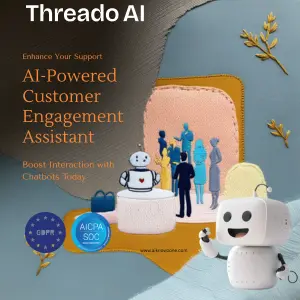Threado AI
Explore how Threado AI simplifies AI infrastructure and workflow management for enterprises, enabling faster AI adoption and innovation.
Description
Threado AI Review: Simplifying AI Workflows for Enterprises
Ever felt overwhelmed by the complexities of AI infrastructure? I know I have! That’s where Threado AI comes in. Threado AI aims to make AI accessible and manageable for businesses, providing a platform to design, implement, and oversee critical AI-powered workflows. It’s like having a dedicated AI infrastructure team, but without the hefty payroll. This innovative platform is designed to streamline the traditionally complex process of integrating AI models, APIs, databases, and ETL systems into a cohesive and manageable workflow. I’ve been exploring how it simplifies the creation and deployment of event-driven, distributed AI applications, and I’m excited to share my findings!
Key Features and Benefits of Threado AI
What makes Threado AI stand out? It’s all about the features designed to make your life easier. From what I’ve gathered, and pieced together, it seems Threado AI’s core strength lies in its composable software architecture. This allows organizations to build and customize AI workflows to fit their specific needs. It’s not a one-size-fits-all solution; instead, it provides building blocks that can be assembled to create tailored AI solutions. The modular nature of the platform also ensures reusability and scalability, meaning that once a workflow is created, it can be easily adapted and expanded as business requirements evolve. Threado AI emphasizes the importance of human oversight, acknowledging that AI workflows often require guidance and direction. By incorporating contextual understanding and subjective evaluation at critical stages, the platform ensures that AI-driven decisions are aligned with business goals and ethical considerations. Here are a few key aspects that seem to define it:
- Composable Workflows: Build modular, reusable AI workflows.
- Unified Platform: Integrate AI models, APIs, databases, and ETL systems in one place.
- Human Oversight: Incorporate human guidance and control at critical stages.
- Simplified Infrastructure: Makes AI infrastructure simple for enterprises.
How Threado AI Works (Simplified)
From my understanding, Threado AI operates on a principle of modularity and composability. Essentially, you design your AI workflow by connecting various components like AI models, data sources, and APIs. Think of it like building with LEGO bricks, but instead of plastic, you’re using AI tools. The platform provides a visual interface to assemble these components, allowing you to define the flow of data and the sequence of operations. Once the workflow is designed, Threado AI takes care of the infrastructure needed to run it, handling the deployment, scaling, and monitoring of the AI application. This abstraction of the underlying infrastructure allows developers to focus on the logic of the AI workflow rather than getting bogged down in the complexities of system administration. I also learned about ‘Lemma,’ which seems to be a core component. Lemma serves as the ‘helping theorem,’ providing the infrastructure for composable, reusable, and modular AI workflows.
Real-World Use Cases for Threado AI
I can see how Threado AI could be a game-changer in various scenarios. Imagine these situations:
- Customer Support Automation: A company uses Threado AI to create an AI bot that answers customer queries instantly via Slack, Discord, or their website. I could see this being useful for handling routine inquiries, freeing up human agents to focus on more complex issues.
- Fraud Detection: A financial institution deploys a Threado AI-powered workflow to analyze transaction data in real-time, identifying and flagging potentially fraudulent activities. I think this would be incredibly valuable in preventing financial losses and protecting customers.
- Personalized Marketing: An e-commerce business utilizes Threado AI to create personalized marketing campaigns based on customer behavior and preferences. This could lead to higher conversion rates and increased customer loyalty. I’m sure many businesses would find that appealing.
Pros of Threado AI
- Simplified AI Infrastructure: Reduces the complexity of managing AI deployments.
- Composable Workflows: Enables flexible and reusable AI solutions.
- Human-in-the-Loop: Supports incorporating human expertise for better decision-making.
Cons of using Threado AI
- Limited Public Information: Detailed documentation and case studies are not yet widely available.
- Potential Learning Curve: Understanding the composable workflow approach may require some initial effort.
Threado AI Pricing
Pricing information wasn’t readily available on the website during my research. You’ll likely need to contact Threado AI directly for specific pricing details based on your use case.
Conclusion
In conclusion, Threado AI presents a promising solution for enterprises looking to harness the power of AI without getting bogged down in infrastructure complexities. Its focus on composable workflows and human oversight makes it a versatile platform for a wide range of applications. If you’re a business seeking to drive innovation and efficiency through AI, Threado AI is definitely worth exploring. While detailed pricing and case studies might require direct engagement, the potential benefits of simplified AI workflow management make it a compelling option to consider. I think it’s a tool that could genuinely help companies make the most of their AI investments. 🚀🤖



Reviews
There are no reviews yet.